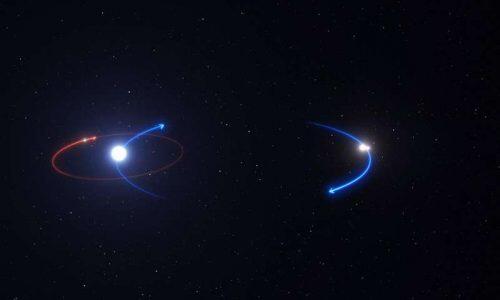Who doesn’t like watching a scenery of a beautiful sunset, or even sunrise?… Now imagine that you could see these sceneries 3 times per day, wouldn’t it be breathtaking? It is not just in fairytales, especially with the place revealed by astronomers yesterday. According to astronomers, the Constellation Centaurus has three suns.
Discoverer and lead author Kevin Wagner said he’s thrilled “to have seen such a beautiful part of nature that nobody else has seen.”
The doctoral student at the University of Arizona at Tucson said “As amazing as three sunsets and sunrises are, I think nature will have some other surprises in store for us as we continue exploring.”
According to phys.org, Triple-star systems with detected planets are rare enough; this is believed to be just the fifth such discovery. But the giant gassy world in this one — formally known as Planet HD 131399Ab — has the biggest known orbit in a multi-star system.
This graphic shows the orbit of the planet in the HD 131399 system (red line) and the orbits of the stars (blue lines). Credit: ESO
Its orbit is double Pluto’s — or roughly 550 Earth years. That’s how long it takes to orbit its system’s brightest star, a super-size sun. The two smaller stars orbit one another and, as a pair, orbit with their big stellar brother.
A year in the newly discovered planet lasts half a millennium from Earth’s perspective.
What is it like at the the Constellation Centaurus?
Kevin Wagner, a first-year PhD student in Apai’s research group and the paper’s first author, who discovered HD 131399Ab said: “For about half of the planet’s orbit, which lasts 550 Earth-years:
- Three stars are visible in the sky, the fainter two always much closer together, and changing in apparent separation from the brightest star throughout the year
- For much of the planet’s year the stars appear close together, giving it a familiar night-side and day-side with a unique triple-sunset and sunrise each day
- As the planet orbits and the stars grow further apart each day, they reach a point where the setting of one coincides with the rising of the other – at which point the planet is in near-constant daytime for about one-quarter of its orbit, or roughly 140 Earth-years.”
Wagner identified the planet among hundreds of candidate planets and led the follow-up observations to verify its nature.
SPHERE
The planet marks the first discovery of an exoplanet made with SPHERE, one of the world’s most advanced instruments dedicated to finding planets around other stars.
- SPHERE stands for the Spectro-Polarimetric High-Contrast Exoplanet Research Instrument
- It is sensitive to infrared light, making it capable to detect the heat signatures of young planets, along with sophisticated features correcting for atmospheric disturbances and blocking out the otherwise blinding light of their host stars
- The instrument is part of the Very Large Telescope operated by the European Southern Observatory on Cerro Paranal in the Atacama Desert of northern Chile.
Co-author Wagner said that “It is not clear how this planet ended up on its wide orbit in this extreme system, and we can’t say yet what this means for our broader understanding of the types of planetary systems out there, but it shows there is more variety out there than many would have deemed possible.”
“What we do know is that planets in multi-star systems are much less explored, and potentially just as numerous as planets in single-star systems.”
Share your thoughts on a triple sunset, sunrise world on our Facebook page greenarea.info












